Results published from shipping’s first-ever full cradle-to-grave lifecycle assessment

Results have been published of shipping’s first-ever full cradle-to-grave lifecycle assessment of a vessel from the raw materials dug from a mine needed to manufacture a hull block to the welder’s torch at its life-end.
The six-month study, conducted by Lloyd’s Register, Knutsen, HD Korea Shipbuilding and Offshore Engineering and HD Hyundai Heavy Industries, measured the carbon emissions generated throughout the entire life cycle of a 174,000 cu m Knutsen newbuild LNG carrier, from raw material extraction to shipbuilding, operation, and demolition.
Research carried out reveals the majority of emissions are created during the operational period of a vessel’s life cycle, but that these can be reduced by approximately 90% through the use of zero- or low-carbon fuels.
Of the overall operations figure, 79% of GHG emissions are generated through ship operations (tank-to-wake), with 21% attributed to mining and transport (well-to-tank) of the fuels, highlighting the significant positive impact of low- or zero-carbon fuels on emissions reduction.
The study also reveals that GHG emissions during the shipbuilding stage can be significantly reduced if green steel – steel with low or zero GHG emissions embodied at the manufacturing stage – is introduced into the process. The use of renewable energy could also lead to a GHG emissions reduction of around 60% at the yard level.
The study took into account all emissions (scope 1, 2 and 3) associated with the vessel throughout its life cycle. Scope 1 emissions are the direct emissions created during shipbuilding and operation. Scope 2 emissions are indirect emissions related to energy, water and steam, for example powering the yard during the build. Scope 3 emissions encompass indirect emissions created both upstream (supply chain) and downstream (distribution chain), for example, emissions created during production, transport and storage of materials and equipment, and during the vessel recycling process. By incorporating all three scopes a complete emissions profile over a vessel’s life cycle can be obtained.
LR chief commercial officer Andy McKeran noted how International Maritime Organization regulations are progressively evolving to encompass the entire value chain and scope 3 emissions disclosures are gaining traction.
Knutsen director of newbuilding and innovation Jarle Østenstad agreed, pointing out that with the forthcoming European Union Corporate Social Responsibility Directive (CSRD), and other similar regulations across the globe, shipowners will be required to produce sustainability reports disclosing their scope 3 emissions and outline strategies for mitigation.
“This life cycle assessment analysis brings owners one step closer to meeting these requirements,” Østenstad said.
